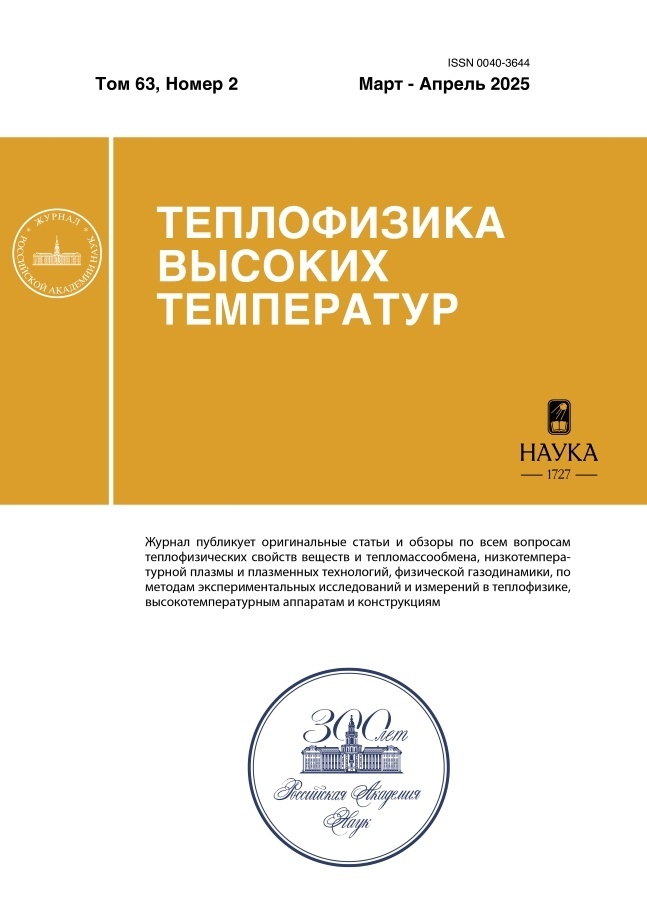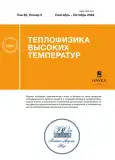Об ускорении и удержании ионов полем виртуального катода в плазме наносекундного вакуумного разряда
- Authors: Куриленков Ю.К.1, Самойлов И.С.1
-
Affiliations:
- Объединенный институт высоких температур РАН
- Issue: Vol 62, No 5 (2024)
- Pages: 655–660
- Section: Plasma Investigations
- URL: https://modernonco.orscience.ru/0040-3644/article/view/682239
- DOI: https://doi.org/10.31857/S0040364424050023
- ID: 682239
Cite item
Abstract
Ранее на основе миниатюрного наносекундного вакуумного разряда малой энергии была реализована схема инерциального электростатического удержания с обратной полярностью. В эксперименте и PiC-моделировании обнаружена возможность удержания и ускорения ионов до энергий в десятки кэВ полем виртуального катода в наносекундном вакуумном разряде. Экспериментально получены как DD-нейтроны, так и α -частицы из безнейтронной реакции протон–бор. В данной работе приводятся результаты PiC-моделирования в электромагнитном коде КАРАТ процессов, приводящих к реакции протон–бор для реальной геометрии электродов, использованной в первых экспериментах по безнейтронному синтезу в одном миниатюрном устройстве на основе наносекундного вакуумного разряда. Из них следует, что общий выход α -частиц происходит в эксперименте за счет лишь разовых схождений протонов и ионов бора к оси разряда, ускоряемых в очень узкой потенциальной яме, а осцилляций ионов за время приложенного импульса напряжения практически нет. Формирование более объемной потенциальной ямы (широкой по радиусу и протяженной по оси разряда) с хорошо выраженными осцилляциями протонов и ионов бора может обеспечить заметное увеличение выхода реакции протон–бор.
Full Text
About the authors
Ю. К. Куриленков
Объединенный институт высоких температур РАН
Author for correspondence.
Email: yu.kurilenkov@lebedev.ru
Russian Federation, г. Москва
И. С. Самойлов
Объединенный институт высоких температур РАН
Email: yu.kurilenkov@lebedev.ru
Russian Federation, г. Москва
References
- Дубинов А.Е., Корнилова И.Ю., Селимир В.Д. Коллективное ускорение ионов в системах с виртуальным катодом // УФН. 2002. Т. 172. № 11. С. 1225.
- Баренгольц С.А., Месяц Г.А., Перельштейн Э.А. Модель коллективного ускорения ионов в вакуумном разряде на основе концепции глубокой потенциальной ямы // ЖЭТФ. 2000. Т. 118. Вып. 6(12). С. 1358.
- Баренгольц С.А., Месяц Г.А., Перельштейн Э.А. Феноменологическая модель неустойчивой стадии вакуумного искрового разряда // ЖТФ. 2009. Т. 79. Вып. 10. С. 45.
- Miley G.H., Murali S.K. Inertial Electrostatic Confinement (IEC) Fusion Fundamentals and Applications. N.Y.: Springer, 2014.
- Lavrent’ev O.A. Electrostatic and Electromagnetic High-temperature Plasma Traps // Ann. N.Y. Acad. Sci. 1975. V. 251. P. 152.
- Elmore W.C., Tuck J.L., Watson K.M. On the Inertial-electrostatic Confinement of a Plasma // Phys. Fluids. 1959. V. 2. P. 239.
- Kurilenkov Yu.K., Skowronek M., Dufty J. Multiple DD Fusion Events at Interelectrode Media of Nanosecond Vacuum Discharge // J. Phys. A: Math. Gen. 2006. V. 39. P. 4375.
- Kurilenkov Yu.K., Tarakanov V.P., Skowronek M., Gus’kov S.Yu., Dufty J. Inertial Electrostatic Confinement and DD Fusion at Interelectrode Media of Nanosecond Vacuum Discharge. PIC Simulations and Experiment // J. Phys. A: Math. Theor. 2009. V. 42. 214041.
- Kurilenkov Yu.K., Tarakanov V.P., Gus’kov S.Yu., Karpukhin V.T., Valyano V.E. Warm Dense Matter Generation and DD Synthesis at Vacuum Discharge with Deuterium-loaded Pd Anode // Contrib. Plasma Phys. 2011. V. 51. P. 427.
- Kurilenkov Yu.K., Tarakanov V.P., Gus’kov S.Yu., Oginov A.V., Karpukhin V.T. Oscillating Ions under Inertial Electrostatic Confinement (IEC) Based on Nanosecond Vacuum Discharge // Contrib. Plasma Phys. 2018. V. 58. P. 952.
- Andreev S.N., Kurilenkov Yu.K., Oginov A.V. Fully Electromagnetic Code KARAT Applied to the Problem of Aneutronic Proton–Boron Fusion // Mathematics. 2023. V. 11. 4009.
- Atzeni S., Meyer-ter Vehn J. The Physics of Inertial Fusion: Beam Plasma Interaction, Hydrodynamics, Hot Dense Matter. Oxford: Oxford University Press, 2004. V. 125.
- Oliphant M., Rutheford L. Experiments on the Transmutation of Elements by Protons // Proc. R. Soc. Lond. 1933. V. A141. P. 259.
- Dee P.I., Gilbert C.W. The Disintegration of Boron into Three α -particles // Proc. R. Soc. Lond. 1936. V. 154. P. 279.
- McKenzie W., Batani D., Mehlhorn T.A., Margarone D., Belloni F., Campbe E.M. et al. HB11–Understanding Hydrogen-Boron Fusion as a New Clean Energy Source // J. Fusion Energy. 2023. V. 42. P. 17. doi: 10.1007/s10894-023-00349-9.
- Cirrone G.A.P., Manti L., Margarone D., Petringa G., Giuffrida L., Minopoli A. et al. First Experimental Proof of Proton Boron Capture Therapy (PBCT) to Enhance Protontherapy Effectiveness // Sci. Rep. 2018. V. 8. № 1. P. 1141.
- Hong E., Jungmin A. et al. Alpha Particle Effect on Multi-nanosheet Tunneling Field-effect Transistor at 3-nm Technology Node // Micromachines. 2019. V. 10. № 12. P. 847.
- Takacs S., Hermanne A., T á rk á nyi F., Ignatyuk A. Cross-sections for Alpha Particle Produced Radionuclides on Natural Silver // Nuclear Instruments and Methods in Physics Research Section B: Beam Interactions with Materials and Atoms. 2010. V. 268. P. 2.
- Belyaev V.S., Matafonov A.P., Vinogradov V.I., Krainov V., Lisitsa V., Rusetski A.S. et al. Observation of Neutronless Fusion Reactions in Picosecond Laser Plasmas // Phys. Rev. E. 2005. V. 72. № 2. 026406.
- Bonvalet J., Nicolai Ph., Rafestin D. et al. Energetic α -particle Sources Produced Through Proton-boron Reactions by High-energy High-intensity Laser Beams // Phys. Rev. E. 2021. V. 103. № 5. 053202.
- Margarone D., Bonvalet J., Giufrida L., Morace A., Kantarelou V., Tosca M. et al. In-Target Proton – Boron Nuclear Fusion Using a PW-Class Laser // Appl. Sci. 2022. V. 12. P. 1444.
- Magee R.M., Ogawa K., Tajima T., Allfrey I., Gota H., McCarroll P. et al. First Measurements of p11B Fusion in a Magnetically Confined Plasma // Nature Commun. 2023. V. 14. P. 955.
- Kurilenkov Yu.K., Oginov A.V., Tarakanov V.P., Gus’kov S.Yu., Samoylov I.S. Proton-boron Fusion in a Compact Scheme of Plasma Oscillatory Confinement // Phys. Rev. E. 2021. V. 103. 043208.
- Kurilenkov Yu.K., Tarakanov V.P., Gus’kov S.Yu. Simulation of Proton–boron Nuclear Burning in the Potential Well of Virtual Cathode at Nanosecond Vacuum Discharge // J. Phys.: Conf. Ser. 2016. V. 774. 012133.
- Kurilenkov Yu.K., Tarakanov V.P., Oginov A.V., Gus’kov S.Yu., Samoylov I.S. Oscillating Plasmas for Proton-Boron Fusion in Miniature Vacuum Discharge // Laser Part. Beams. 2023. 9563197.
- Kurilenkov Yu.K., Andreev S.N. On Scaling of Proton-Boron Fusion Power in a Nanosecond Vacuum Discharge // Frontiers in Physics (Fusion Plasma Physics). 2024. doi: 10.3389/fphy.2024.1440040.
Supplementary files











